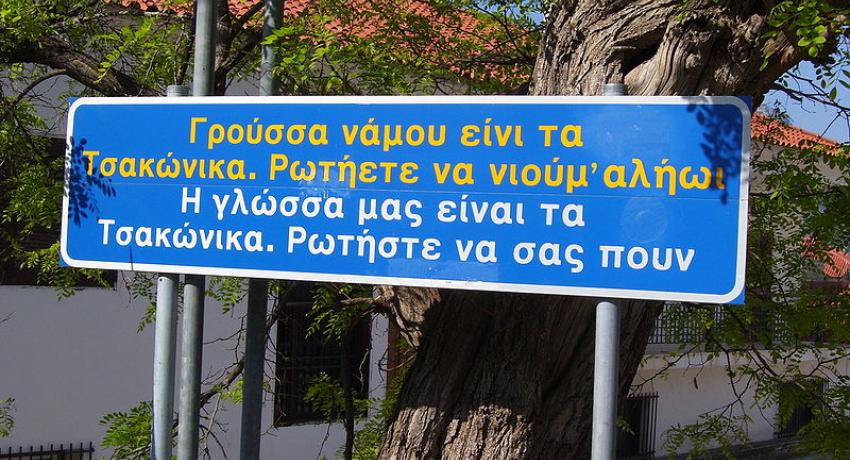Tsakonian (also Tsaconian, Tzakonian or Tsakonic; Tsakonian: τσακώνικα, α τσακώνικα γρούσσα; Greek: τσακώνικα) is a modern Hellenic language which is both highly divergent from other spoken varieties of Modern Greek and, from a philological standpoint, is also linguistically classified separately from them. It is spoken in the Tsakonian region of the Peloponnese, Greece. Tsakonian descends from Doric, which was an Ancient Greek language on the Western branch of Hellenic languages, and it is its only living descendan (along with the debatable Maniot dialect of Modern Greek). Although Tsakonian is treated as a dialect of Modern Standard Greek, some compendia treat it as a separate language since Modern Standard Greek descends from Ionic and Attic which are on the Eastern branch of the Hellenic languages, while Tsakonian (as a descendant of Doric) is the sole surviving member of the Western branch.
Tsakonian is critically endangered, with only a few hundred, mostly elderly, fluent speakers left.[7] Tsakonian and Modern Greek are not mutually intelligible.
Tsakonian is found today in a group of mountain towns and villages slightly inland from the Argolic Gulf, although it was once spoken farther to the south and west as well as on the coasts of Laconia (ancient Sparta). There was formerly a Tsakonian colony on the Sea of Marmara(or Propontis; two villages near Gönen, Vatika and Havoutsi), probably dating from the 18th century, whose members were resettled in Greece with the 1924 population exchangesPropontis Tsakonian appears to have died out around 1970.
Geographical barriers to travel and communication kept the Tsakonians relatively isolated from the rest of Greece until the 19th century, although there was some trade between the coastal towns. The rise of mass education and improved travel beginning after the Greek War of Independence meant that fluent Tsakonian speakers were no longer as isolated from the rest of Greece. In addition, during the war, the Turkish army drove the Tsakonians east, and as a result, their de facto capital shifted from Prastos to Leonidio, further making the people significantly less isolated. There began a rapid decline from an estimated figure of some 200,000 fluent speakers to the present estimate of a speaker count between 200 and 1,000
Since the introduction of electricity to all villages in Tsakonia by the late 1950s, the Greek mass media can reach the most remote of areas and profoundly affect the speech of younger speakers. Efforts to revive the language by teaching it in local schools do not seem to have had much success. Standard Modern Greek is the official language of government, commerce and education, and it is possible that the continued modernization of Tsakonia will lead to the language's disappearance sometime this century.[citation needed]
The area where the language is found today in some villages Tsakonia slopes of Parnon in the southern province of Kynouria, including the towns of Leonidio and Tyros and villages of Melana, Agios Andreas, Vaskina, Prastos, Sitaina and Kastanitsa.
Check the Dictionary of Tsakonian Dialect.

